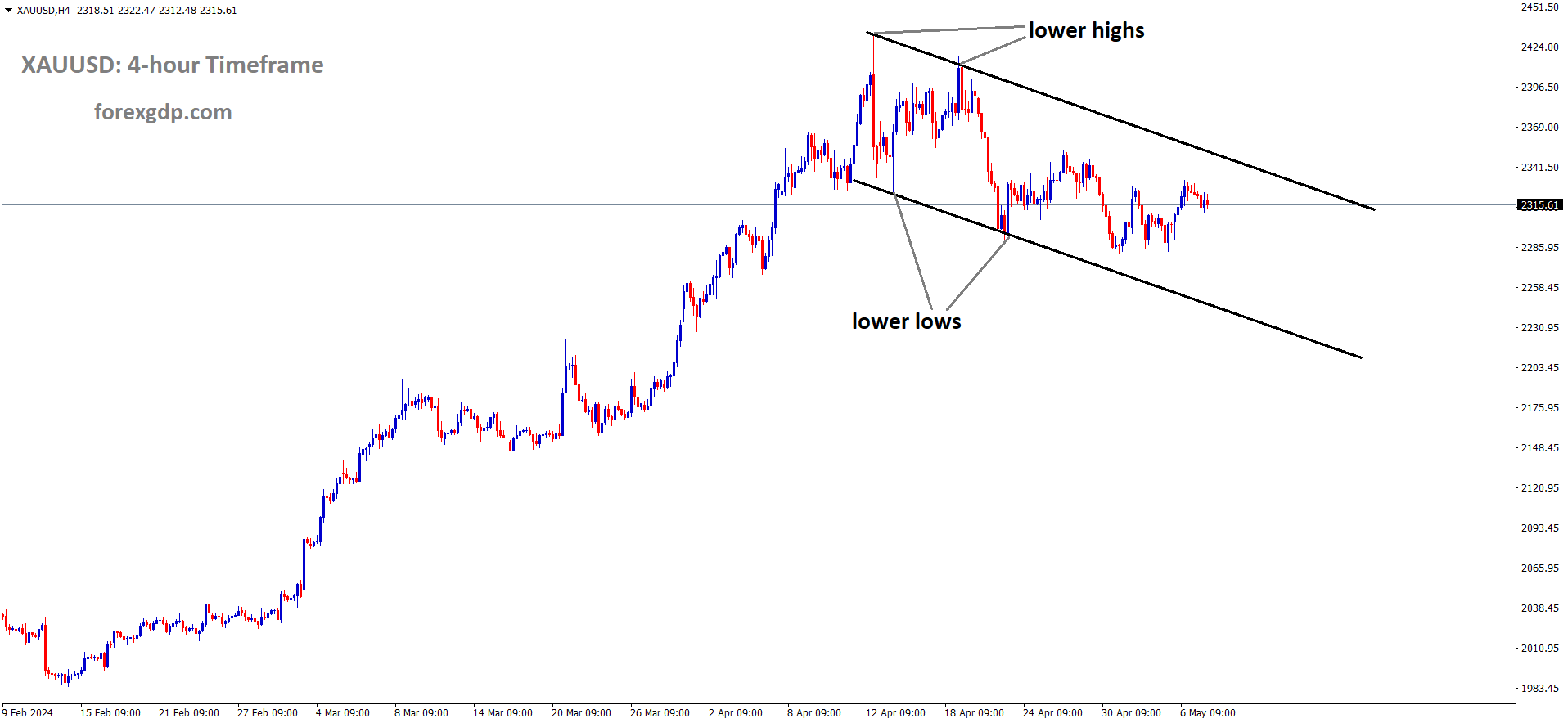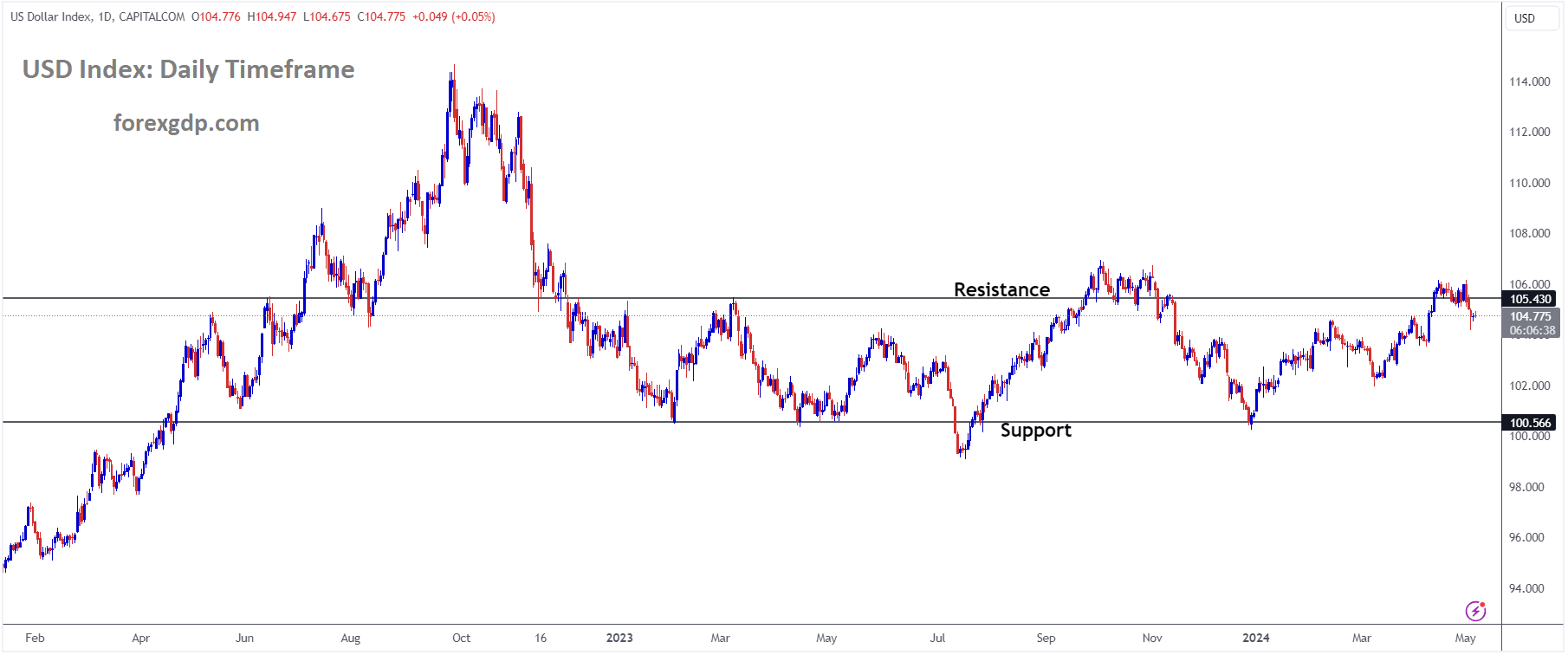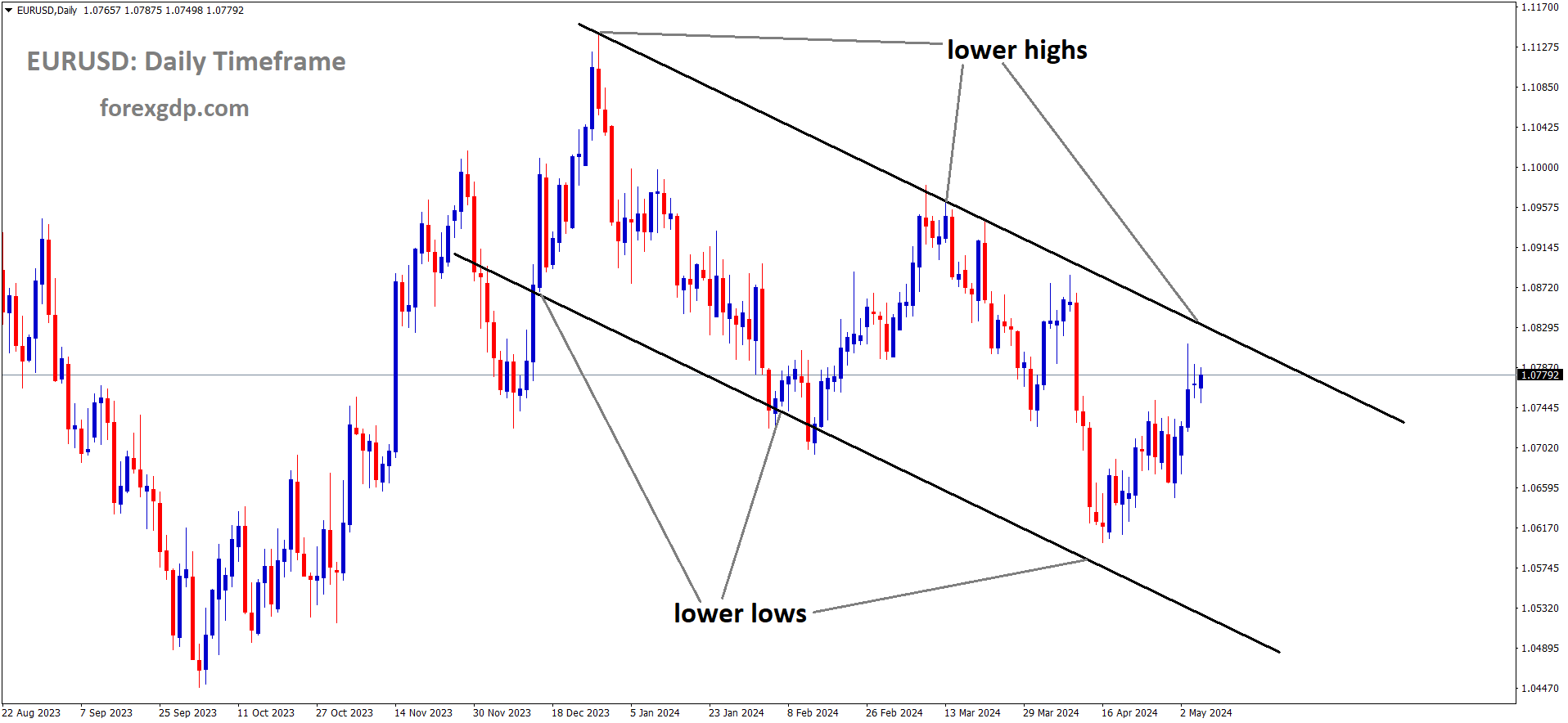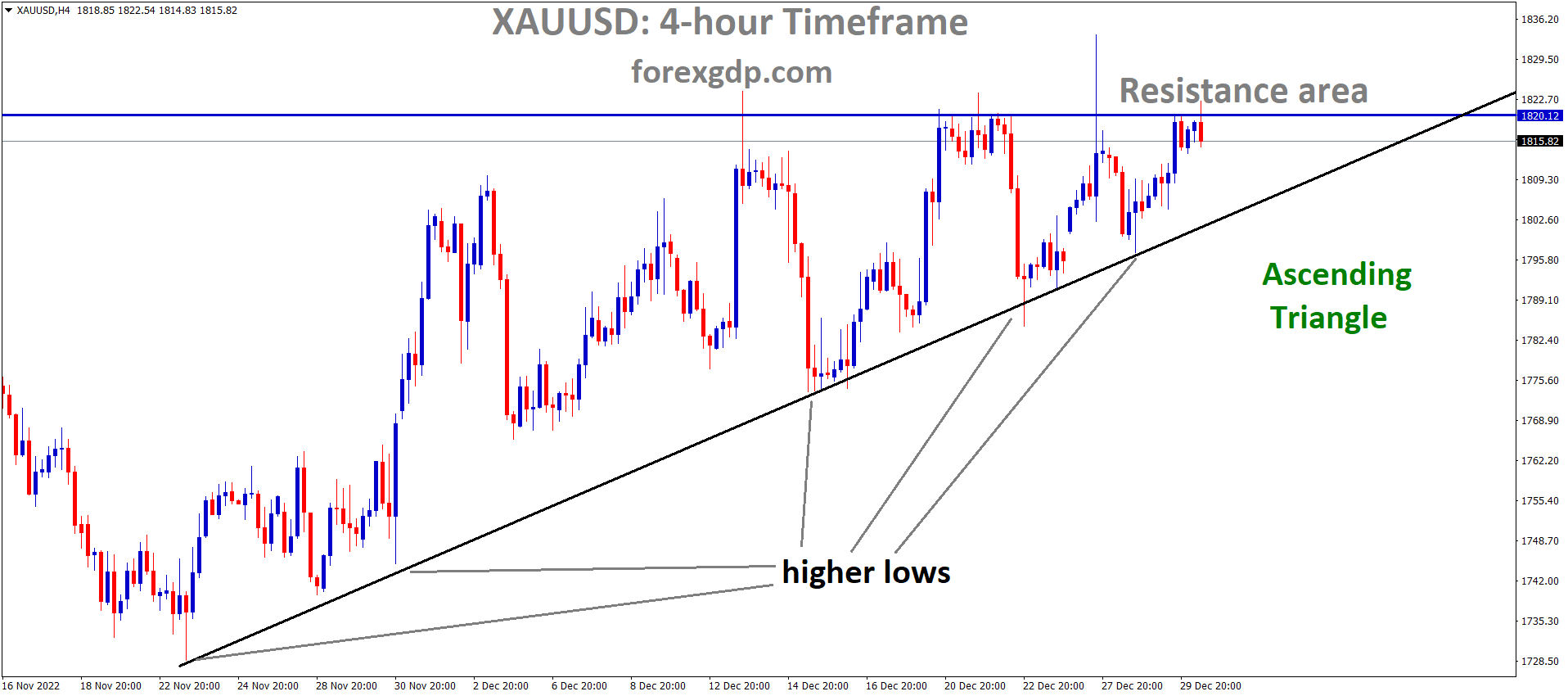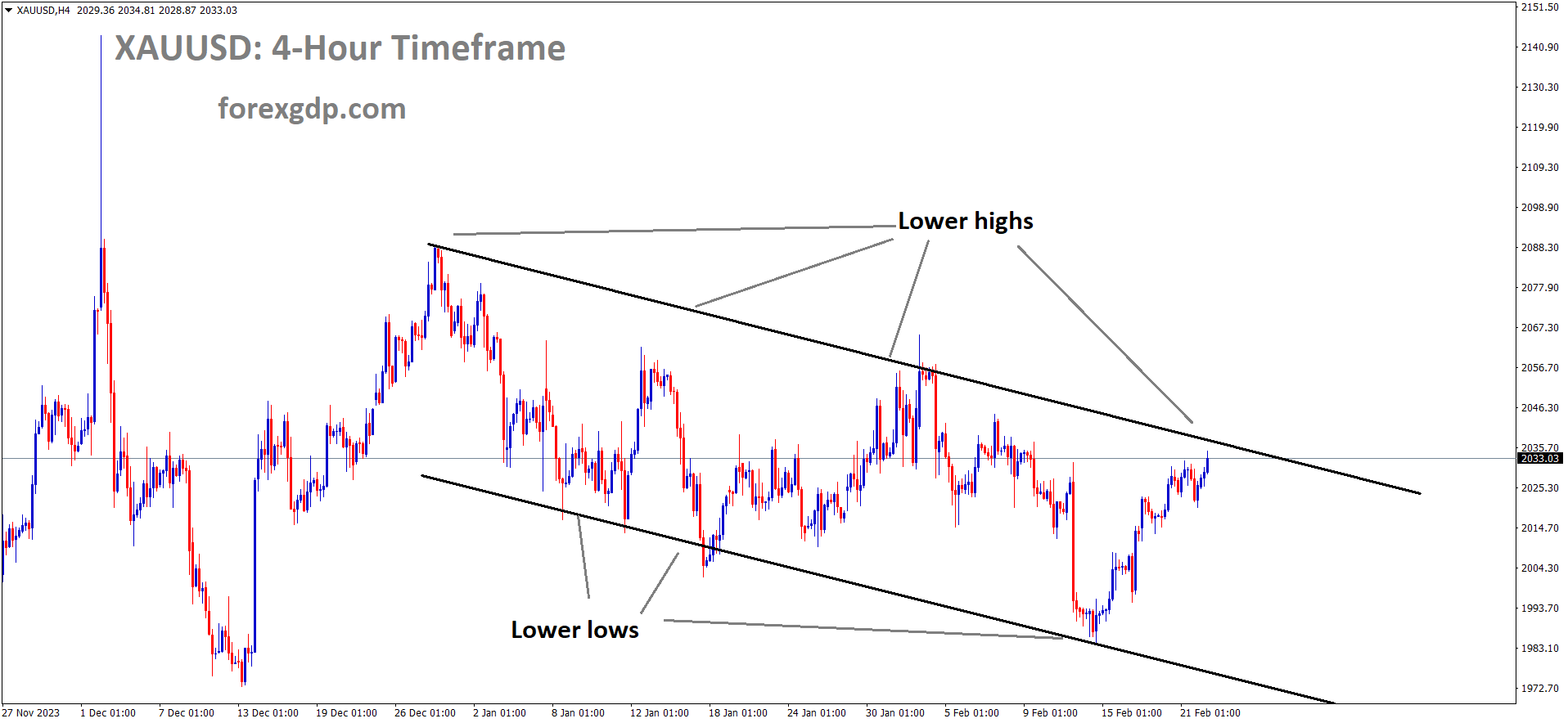USD: Kashkari: Housing Market Resilience Amid Tighter Policy
Neel Kashkari, the President of the Federal Reserve Bank of Minneapolis, recently articulated observations regarding the nuanced trajectory of inflation within the United States, characterizing its lateral movement. This state of inflationary ambivalence has engendered a conundrum within the Federal Reserve, prompting deliberations on the optimal policy response, notably pondering the prospect of either initiating a rate hike or implementing a rate cut.
XAUUSD is moving in Descending channel and market has rebounded from the lower low area of the channel
Despite the palpable vigor exhibited by the US housing market, underscored by sustained demand from prospective homebuyers, the desired threshold of inflation, namely the Federal Reserve’s 2% target, remains an elusive objective. Consequently, the prevailing policy stance is one of cautious restraint, persisting throughout the current year, contingent upon the eventual moderation of housing market fervor and a corresponding abatement in labor market fervency.
Kashkari’s tenor, characterized by a hawkish inclination, has elicited discernible market repercussions, notably delineated by a discernible fortification of the US dollar vis-à-vis its currency counterparts. This market response underscores the acute sensitivity to prospective shifts in monetary policy dynamics.
The housing market is displaying a remarkable resilience to the effects of stringent monetary policy, showcasing a level of endurance not previously witnessed. This durability in the housing sector prompts speculation that the neutral rate, particularly in the short term, may have been elevated. Despite the progress observed in inflation during the latter part of 2023, recent indications suggest a halt in this progression, leading to uncertainties regarding whether disinflationary forces persist or if a prolonged adjustment period is underway.
Furthermore, although recent GDP growth has been sluggish, primarily attributed to inventory adjustments and net exports, the fundamental demand in the economy remains robust. The inversion of the yield curve serves as a signal that policy measures are, indeed, restrictive.
In response to these developments, Neel Kashkari, President of the Federal Reserve Bank of Minneapolis, has marginally revised his estimate of the neutral rate, elevating it from 2% to 2 1/2%. However, despite this adjustment, the underlying strength of the economy remains somewhat perplexing, given the prevailing circumstances.
The stagnation observed in inflation trends poses further questions regarding the efficacy of current policy measures in curbing price pressures. There’s a possibility that policymakers’ misperception of the current neutral rate could offer an explanation for the divergence between anticipated and actual outcomes.
These updates to the economic outlook were detailed in Kashkari’s latest essay, reflecting ongoing assessments and deliberations within the Federal Reserve regarding monetary policy and its implications for the broader economy.
USD: Kashkari: Policy Tightness Questioned Amid Stalling Inflation
Neel Kashkari, President of the Federal Reserve Bank of Minneapolis, recently commented on the trajectory of inflation in the United States, noting its sideways movement. This indecision regarding inflation dynamics has led to uncertainties within the Federal Reserve regarding the appropriate course of action, specifically concerning whether to implement a rate hike or a rate cut.
USD Index Market price is moving in box pattern and market has fallen from the resistance area of the pattern
Despite the lack of substantial inflationary pressure, the US housing market continues to display robust demand from homebuyers. However, inflation has yet to reach the Federal Reserve’s target of 2%. Consequently, the current policy stance remains restrictive throughout the year, pending a cooldown in the housing market and a moderation in labor market data.
Kashkari’s hawkish remarks have contributed to a strengthening of the US dollar against its currency counterparts, reflecting market interpretations of potential shifts in monetary policy.
Neel Kashkari, President of the Federal Reserve Bank of Minneapolis, recently highlighted concerns regarding recent inflation trends, questioning whether current monetary policy is adequately restrictive to steer price growth back to the central bank’s 2% target.
Kashkari specifically noted the persistent inflationary pressures in the housing sector as a potential indication that neutral interest rates—those neither stimulating nor restraining the economy—might be higher in the short term. In an essay published on the bank’s website on Tuesday, he suggested that this situation might necessitate further efforts from the Fed to curb inflation.
Expressing contentment with the resilient labor market, Kashkari underscored the significance of inflation data stagnating in the last quarter, prompting doubts about the true restrictiveness of policy measures. He emphasized the crucial role of housing in transmitting the effects of monetary policy and suggested that the current resilience in this sector could indicate a misperception of the neutral rate, at least in the near term.
Kashkari disclosed that he revised his longer-term neutral rate projection to 2.5% from 2%, a move echoed by some colleagues on the Federal Open Market Committee. Despite not having voting privileges on monetary policy this year, he stressed the necessity of aligning policy decisions with the prevailing short-term neutral rate.
Highlighting the challenges stemming from uncertainty surrounding the current neutral rate, Kashkari stressed the need for policymakers to base their decisions on this variable.
The essay reflects ongoing deliberations within the Federal Reserve regarding inflation dynamics and the appropriate stance of monetary policy. Despite expectations of interest rate cuts earlier in the year, stronger-than-anticipated inflation metrics have led to a reassessment of such measures, with investors now anticipating fewer rate reductions in 2024 compared to initial forecasts.
Inflationary pressures, as measured by the Fed’s preferred gauge, remain a focal point, having moderated from previous peaks but still exceeding levels seen earlier in the year. Housing shortages continue to drive inflation, maintaining elevated prices even amidst historically high mortgage rates.
Kashkari’s commentary marks a continuation of his engagement with inflationary concerns and monetary policy, underscoring the evolving economic landscape post-pandemic. He is scheduled to further elaborate on these issues at the Milken Institute Global Conference later on Tuesday.
USD: Kashkari: Sideways Inflation Raises Policy Questions
The Minnaepolis FED President Neel Kashkari said inflation in the US moving Sideways and FED what to do rate hike or cut it is questionable. The US Housing Market shows demand by the US Home buyers So inflation still not come to our target of 2%. So policy stance remains restrictive in this year until Housing market cools down, Labour data cool down. Hawkish message from Kashkari helped US Dollar moved higher against Counter pairs.
EURUSD is moving in Descending channel and market has reached lower high area of the channel
Neel Kashkari, President of the Federal Reserve Bank of Minneapolis, offered insights on Tuesday, highlighting concerns regarding the trajectory of inflation and its implications for monetary policy, as reported by Reuters.
Kashkari underscored the remarkable resilience of the housing market in the face of stringent monetary policy measures, surpassing historical precedents. This resilience prompts speculation that the neutral rate may have been elevated, particularly in the short term, to accommodate the market’s steadfastness.
Furthermore, Kashkari noted a perceived halt in the progress of inflation during the latter half of 2023, prompting questions regarding the underlying dynamics. The prevailing uncertainty revolves around whether disinflationary pressures persist or if a protracted adjustment period is underway.
Examining broader economic indicators, Kashkari acknowledged a recent deceleration in GDP growth attributed to inventory adjustments and net exports. However, he emphasized that the underlying demand in the economy remains robust, contributing to its overall resilience.
The inversion of the yield curve, according to Kashkari, signals a tightening of policy measures, further underscoring the challenges faced by policymakers in navigating the current economic landscape.
In discussing the factors sustaining the housing market, Kashkari pointed to inadequate supply dynamics, coupled with potential demand boosts from immigration and remote work arrangements.
The persistent stagnation in inflation trends continues to raise doubts about the appropriateness of existing policy measures in addressing price pressures. Kashkari suggested that policymakers’ misperceptions of the current neutral rate could offer insights into the observed economic data.
These observations by Kashkari shed light on ongoing deliberations within the Federal Reserve regarding the intricacies of monetary policy and its impact on various sectors of the economy.
Don’t trade all the time, trade forex only at the confirmed trade setups
Get more confirmed trade signals at premium or supreme – Click here to get more signals , 2200%, 800% growth in Real Live USD trading account of our users – click here to see , or If you want to get FREE Trial signals, You can Join FREE Signals Now!


